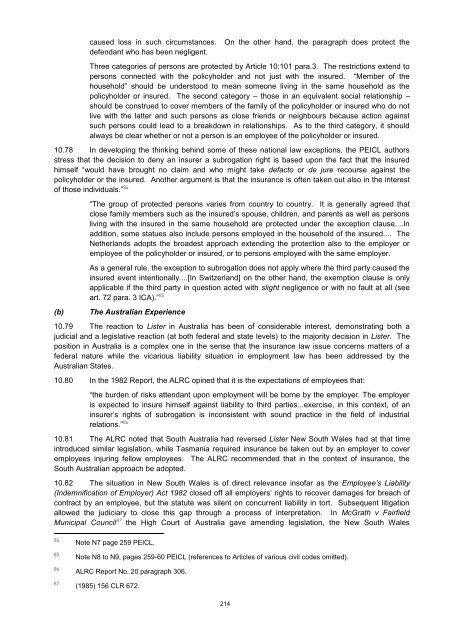Insurance Contracts CP - Law Reform Commission
Insurance Contracts CP - Law Reform Commission
Insurance Contracts CP - Law Reform Commission
You also want an ePaper? Increase the reach of your titles
YUMPU automatically turns print PDFs into web optimized ePapers that Google loves.
caused loss in such circumstances.<br />
defendant who has been negligent.<br />
On the other hand, the paragraph does protect the<br />
Three categories of persons are protected by Article 10:101 para.3. The restrictions extend to<br />
persons connected with the policyholder and not just with the insured. ―Member of the<br />
household‖ should be understood to mean someone living in the same household as the<br />
policyholder or insured. The second category – those in an equivalent social relationship –<br />
should be construed to cover members of the family of the policyholder or insured who do not<br />
live with the latter and such persons as close friends or neighbours because action against<br />
such persons could lead to a breakdown in relationships. As to the third category, it should<br />
always be clear whether or not a person is an employee of the policyholder or insured.<br />
10.78 In developing the thinking behind some of these national law exceptions, the PEICL authors<br />
stress that the decision to deny an insurer a subrogation right is based upon the fact that the insured<br />
himself ―would have brought no claim and who might take defacto or de jure recourse against the<br />
policyholder or the insured. Another argument is that the insurance is often taken out also in the interest<br />
of those individuals.‖ 84<br />
(b)<br />
―The group of protected persons varies from country to country. It is generally agreed that<br />
close family members such as the insured‘s spouse, children, and parents as well as persons<br />
living with the insured in the same household are protected under the exception clause....In<br />
addition, some statues also include persons employed in the household of the insured.... The<br />
Netherlands adopts the broadest approach extending the protection also to the employer or<br />
employee of the policyholder or insured, or to persons employed with the same employer.<br />
As a general rule, the exception to subrogation does not apply where the third party caused the<br />
insured event intentionally....[In Switzerland] on the other hand, the exemption clause is only<br />
applicable if the third party in question acted with slight negligence or with no fault at all (see<br />
art. 72 para. 3 ICA).‖ 85<br />
The Australian Experience<br />
10.79 The reaction to Lister in Australia has been of considerable interest, demonstrating both a<br />
judicial and a legislative reaction (at both federal and state levels) to the majority decision in Lister. The<br />
position in Australia is a complex one in the sense that the insurance law issue concerns matters of a<br />
federal nature while the vicarious liability situation in employment law has been addressed by the<br />
Australian States.<br />
10.80 In the 1982 Report, the ALRC opined that it is the expectations of employees that:<br />
―the burden of risks attendant upon employment will be borne by the employer. The employer<br />
is expected to insure himself against liability to third parties...exercise, in this context, of an<br />
insurer‘s rights of subrogation is inconsistent with sound practice in the field of industrial<br />
relations.‖ 86<br />
10.81 The ALRC noted that South Australia had reversed Lister New South Wales had at that time<br />
introduced similar legislation, while Tasmania required insurance be taken out by an employer to cover<br />
employees injuring fellow employees. The ALRC recommended that in the context of insurance, the<br />
South Australian approach be adopted.<br />
10.82 The situation in New South Wales is of direct relevance insofar as the Employee‟s Liability<br />
(Indemnification of Employer) Act 1982 closed off all employers‘ rights to recover damages for breach of<br />
contract by an employee, but the statute was silent on concurrent liability in tort. Subsequent litigation<br />
allowed the judiciary to close this gap through a process of interpretation. In McGrath v Fairfield<br />
Municipal Council 87 the High Court of Australia gave amending legislation, the New South Wales<br />
84<br />
85<br />
86<br />
87<br />
Note N7 page 259 PEICL.<br />
Note N8 to N9, pages 259-60 PEICL (references to Articles of various civil codes omitted).<br />
ALRC Report No. 20 paragraph 306.<br />
(1985) 156 CLR 672.<br />
214

















